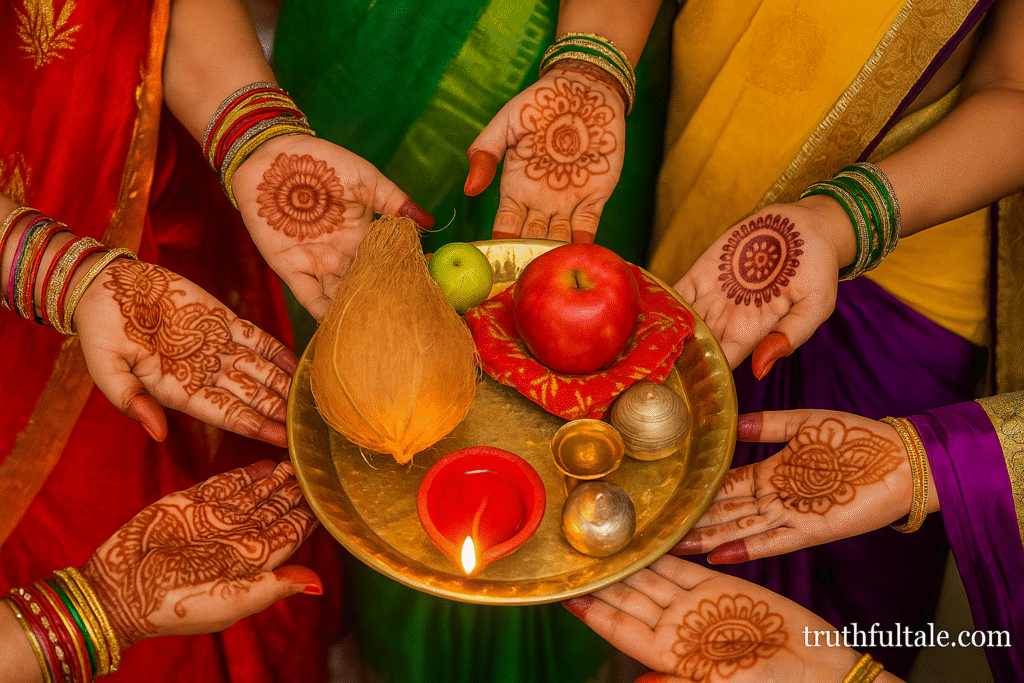Why We Celebrate Teej? – Meaning, Story & Traditions

Teej is a beautiful and joyful festival celebrated mostly by women in India and Nepal. Among the different types of Teej, Hariyali Teej is one of the most popular. It usually falls during the monsoon season (July–August), when the greenery around makes everything look fresh and lively.
But why is Teej celebrated? What is the story behind it? Let’s explore the meaning, history, and traditions of this special day.
The Mythological Story Behind Teej
The festival of Teej is mainly about Goddess Parvati’s love and devotion for Lord Shiva. It tells us that true love is patient, strong, and faithful.
The Love of Parvati and Shiva – A Story of Patience and Faith
A long time ago, Goddess Parvati decided that she wanted to marry Lord Shiva. But Lord Shiva was a great ascetic — he spent all his time meditating in the mountains and was not interested in marriage.
Parvati, however, did not give up. She believed that only Shiva was the right partner for her. To win his heart, she left the comforts of her palace and went to the forest. There, she prayed, meditated, and lived a very simple life.
Her devotion was so strong that she took birth after birth — a total of 108 lifetimes — continuing her prayers in each life. This showed her unshakable determination and love.
Finally, in her 109th birth, Parvati’s penance (tapasya) moved Shiva’s heart. He understood her pure love and agreed to marry her.
It is said that their holy union took place on the day of Hariyali Teej. From then on, the day became a symbol of true love, marital happiness, and faithfulness.
That’s why women celebrate Teej — to honor Parvati’s devotion, to seek blessings for a happy marriage, and to remind themselves that patience and sincerity bring blessings.
Why Married Women and Young Girls Celebrate Teej
Teej is especially important for married women and unmarried young girls.
👰 For Married Women:
- They pray for a long and healthy life of their husbands.
- It is believed that observing the fast and praying to Goddess Parvati brings marital happiness, love, and peace.
👧 For Young Girls:
- They also keep the fast with the hope of getting a loving and caring husband, just like Parvati got Lord Shiva.
Rituals and Traditions of Hariyali Teej

🎡 Swings and Green Clothes:
- Women wear green clothes, bangles, and apply mehendi (henna) on their hands.
- Swings are hung on trees, and girls swing on them while singing Teej songs.
Visiting Parents’ Home:
- Married women often go to their maayka (mother’s home) during this time.
- It becomes a time of fun, bonding, and celebration.
🙏 Fasting and Prayer in Teej Celebrations
One of the most important parts of Teej is the vrat (fast).
🌼 Types of Fast:
- Some women observe nirjala vrat (without water and food) for the whole day and night.
- Others may drink water, but do not eat any food.
🕯️ Worship Ritual:
- In the evening, women gather together and worship Lord Shiva and Goddess Parvati.
- They listen to the Teej Katha (story), sing bhajans, and light lamps.
🌙 Ending the Fast:
- The fast is usually broken the next morning after the prayers are completed.
🕉️ The Spiritual Significance of Teej
Teej is not just a festival, but a reminder of:
- Faith and devotion like Parvati’s love for Shiva.
- Patience and sacrifice that true love often needs.
- The power of prayer and fasting in bringing inner strength.
It connects women with their traditions, families, and culture, and also brings joy through music, dance, and sisterhood.
Final Words
Teej is a celebration of love, devotion, and the strength of women. With stories from mythology, colorful rituals, and deep faith, it brings women together in joy and spirituality. Whether you’re praying for a happy marriage or celebrating your culture, Teej is a beautiful reminder of the power of devotion and tradition.
